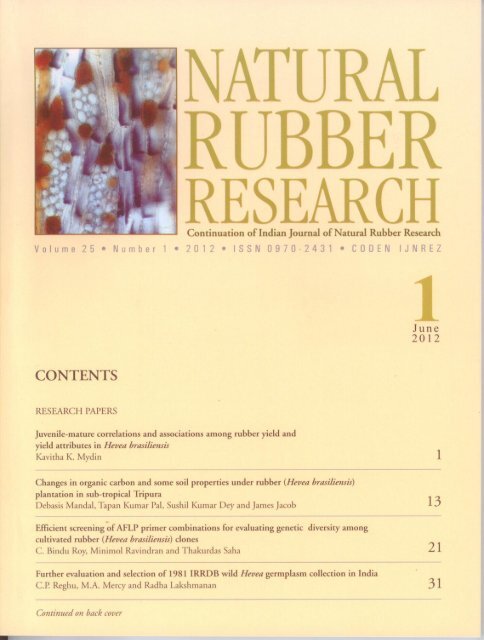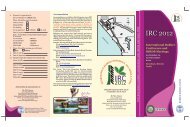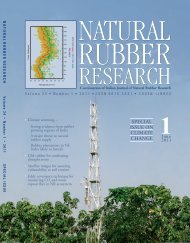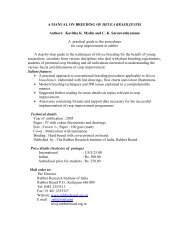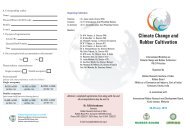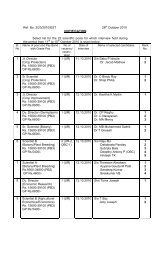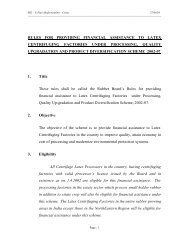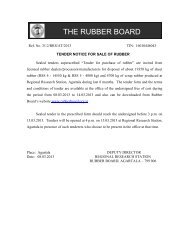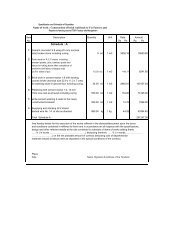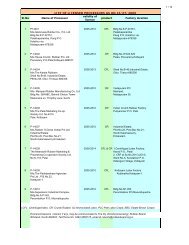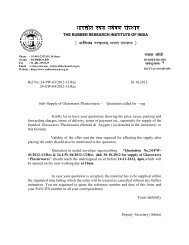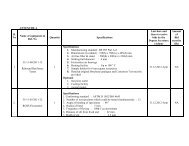(hevea brasiliensis) clones - Rubber Board
(hevea brasiliensis) clones - Rubber Board
(hevea brasiliensis) clones - Rubber Board
You also want an ePaper? Increase the reach of your titles
YUMPU automatically turns print PDFs into web optimized ePapers that Google loves.
Natural <strong>Rubber</strong> Research Volume 25 Number 1 2012<br />
CONTENTS<br />
RESEARCH PAPERS<br />
Juvenile-mature correlations and associations among rubber yield and<br />
yield attributes in Hevea <strong>brasiliensis</strong><br />
Kavitha K. Mydin 1<br />
Changes in organic carbon and some soil properties under rubber<br />
(Hevea <strong>brasiliensis</strong>) plantation in sub-tropical Tripura<br />
Debasis Mandal, Tapan Kumar Pal, Sushil Kumar Dey and James Jacob 13<br />
Efficient screening of AFLP primer combinations for evaluating genetic<br />
diversity among cultivated rubber (Hevea <strong>brasiliensis</strong>) <strong>clones</strong><br />
C. Bindu Roy, Minimol Ravindran and Thakurdas Saha 21<br />
Further evaluation and selection of 1981 IRRDB wild Hevea germplasm<br />
collection in India<br />
C.P. Reghu, M.A. Mercy and Radha Lakshmanan 31<br />
Influence of intercropping on growth of rubber (Hevea <strong>brasiliensis</strong>)<br />
and soil physico-chemical properties<br />
Elsie S. George, Phebe Joseph, M.D. Jessy, Kochuthresiamma Joseph<br />
and N. Usha Nair 39<br />
Methods to improve establishment success and growth of green budded stumps<br />
of Hevea in polybags<br />
V. C. Mercykutty and T. Gireesh 46<br />
Yield performance of clone RRII 105 under low frequency tapping in BO-2<br />
and BI-1 panels<br />
K. Karunaichamy, K.U. Thomas and R. Rajagopal 52<br />
Performance of certain exotic Hevea <strong>clones</strong> in Kanyakumari region<br />
T.A. Soman, M. Suryakumar, Kavitha K. Mydin and M.A. Nazeer 60<br />
Patron<br />
Sheela Thomas IAS<br />
Editor-in-Chief<br />
Dr. James Jacob<br />
Editors<br />
Dr. R. Krishnakumar<br />
Dr. Siby Varghese<br />
Secretary<br />
Dr. C. P. Reghu<br />
EDITORIAL BOARD<br />
Associate Editors<br />
Dr. Kochuthresiamma Joseph<br />
Dr. K. Karunaichamy<br />
Dr. Joshua Abraham<br />
Ms. K. Rekha<br />
Mr. M. J. Reju<br />
Ms. Phebe Joseph<br />
Editorial Committee<br />
Members<br />
Dr. D. Chaudhuri<br />
Dr. A. Thulaseedharan<br />
Dr. Rosamma Alex<br />
Treasurer<br />
CA. Zachariah Kurian
Polyhouse technology for production of healthy planting materials of rubber<br />
V.C. Mercykutty, Kavitha K. Mydin, Shammi Raj, C. Bindu Roy<br />
and P.M. Priyadarshan 68<br />
Detection and isolation of good quality DNA from the latex<br />
of Hevea <strong>brasiliensis</strong><br />
A. Thulaseedharan, R.S. Sajeevan and A. Saleena 77<br />
Histochemical changes in embryogenic and non-embryogenic calli<br />
of Hevea <strong>brasiliensis</strong><br />
P. Kumari Jayasree, C.P. Reghu, R.G. Kala and A. Thulaseedharan 86<br />
Trends in wage share in the context of labour shortage:<br />
The case of tapping wage share in rubber smallholdings sector in Kerala<br />
Binni Chandy and K. Tharian George 91<br />
Effect of storage on properties of natural rubber sheets in Tripura<br />
Joy Joseph, Leelamma Varghese, Sushil Kumar Dey and K.T. Thomas 100<br />
Distribution of protein-storing cells in the bark tissue of Hevea <strong>brasiliensis</strong><br />
in response to tapping panel dryness and stimulation<br />
Vinoth Thomas, C.P. Reghu, V. Divya, P.K. Ambily and R. Krishnakumar 107<br />
Evaluation of polycross seedlings of prepotent Hevea <strong>clones</strong> –<br />
Potential for yield improvement and drought tolerance<br />
M.A. Mercy and Kavitha K. Mydin 115<br />
Figure on cover<br />
Protein-storing cells in the bark tissue<br />
See Vinoth et al., pages 107-114
Natural <strong>Rubber</strong> Research, 25(1): 1-12, 2012<br />
JUVENILE-MATURE CORRELATIONS<br />
AND ASSOCIATIONS AMONG<br />
RUBBER YIELD AND YIELD ATTRIBUTES IN<br />
HEVEA BRASILIENSIS<br />
Kavitha K. Mydin<br />
<strong>Rubber</strong> Research Institute of India, Kottayam-686 009, Kerala, India<br />
Received : 26 September 2011 Accepted : 15 December 2011<br />
Mydin, K.K. (2012). Juvenile-mature correlations and associations among rubber yield and yield attributes<br />
in Hevea <strong>brasiliensis</strong>. Natural <strong>Rubber</strong> Research, 25(1): 1-12.<br />
Early evaluation techniques to shorten the breeding cycle of Hevea have been investigated at large, but<br />
few have systematically studied the juvenile-mature correlations which are of paramount significance in<br />
deciding early selection criteria. A population of 150 polycross seedlings belonging to ten half-sib progenies<br />
was subjected to investigations on correlations among five juvenile traits and 18 mature traits. Juvenilemature<br />
correlations among these traits recorded over three years in the juvenile phase in a nursery and<br />
over 11 years in the subsequent mature phase of the 150 resultant <strong>clones</strong> planted in a compact family<br />
block design in the main field were studied.<br />
Juvenile girth, bark thickness and the number of laticifers emerged as important components showing<br />
positive association with yield determined by test tapping. <strong>Rubber</strong> yield in the first four years of tapping<br />
at maturity was significantly correlated with summer yield, girth, number of latex vessel rows in the<br />
soft bast and clear bole volume. Clear bole volume showed a higher positive correlation with girth<br />
than forking height, an indication that high girthing <strong>clones</strong> can be assumed to give high timber yields.<br />
The juvenile-mature correlations indicated test tap yield of two year old seedlings in the nursery to be<br />
the only juvenile parameter with a significant positive association with yield of the resultant <strong>clones</strong> at<br />
maturity in the main field. Girth, bark thickness and the number of latex vessel rows in the juvenile<br />
seedlings had no association with yield per se in the mature stage and hence, resorting to selection of<br />
seedlings based on juvenile vigour alone would lead to erroneous conclusions and loss of potential<br />
high yielders.<br />
Among the 29 <strong>clones</strong> with high yield at maturity 90% were from the high and moderately high test tap<br />
yield category while only 72% belonged to the moderate to high girth category. Only 7% of the low<br />
juvenile yielders gave high yield at maturity while 25% of the seedlings with low juvenile vigour gave<br />
high yield at maturity. The results suggest that nursery screening based on juvenile yield by test tapping<br />
remains the only reliable criterion in breeding for yield improvement. However, the relatively low<br />
strength of juvenile – mature correlation indicates that a combined and less stringent selection for traits<br />
such as juvenile yield, girth and the number of latex vessel rows in 2- 3 year old seedlings could give<br />
better recovery of high yielding <strong>clones</strong> at maturity.<br />
Keywords: Early evaluation, Girth, Hevea <strong>brasiliensis</strong>, Juvenile-mature correlations, Laticifers, <strong>Rubber</strong> yield,<br />
Timber<br />
Correspondence: Kavitha K. Mydin (Email: kavitha@rubberboard.org.in)<br />
1
Natural <strong>Rubber</strong> Research, 25(1): 13-20, 2012<br />
CHANGES IN ORGANIC CARBON<br />
AND SOME SOIL PROPERTIES UNDER RUBBER<br />
(HEVEA BRASILIENSIS) PLANTATION IN<br />
SUB-TROPICAL TRIPURA<br />
Debasis Mandal, Tapan Kumar Pal, Sushil Kumar Dey and James Jacob*<br />
Regional Research Station, <strong>Rubber</strong> Research Institute of India, Agartala- 799006, Tripura, India<br />
* <strong>Rubber</strong> Research Institute of India, Kottayam-686009, Kerala, India<br />
INTRODUCTION<br />
In North East India, wide spread<br />
deforestation is a common practice mainly<br />
to meet the need for fuel wood, timber,<br />
forage etc. and thus destabilising the ecology<br />
of this region. The soils in this region are<br />
highly degenerated due to shifting<br />
cultivation (Datta et al., 2001) which is<br />
preceded by burning of organic debris in soil<br />
Received : 10 July 2011 Accepted : 24 October 2011<br />
Mandal, D., Pal, T.K., Dey, S.K. and Jacob, J. (2012). Changes in organic carbon and some soil properties<br />
under rubber (Hevea <strong>brasiliensis</strong>) plantation in sub-tropical Tripura. Natural <strong>Rubber</strong> Research, 25(1): 13-20.<br />
Changes in the status of soil organic carbon (SOC), available phosphorus (av. P), available potassium<br />
(av. K), pH and bulk density (BD) were studied in rubber plantations at an interval of two decades in<br />
Tripura. Composite soil samples collected at two depths viz. 0-30 cm (surface soil) and 30-60 cm (subsurface<br />
soil) during 1986 and 2006 from growers’ fields, were analyzed for the physico-chemical properties.<br />
The data showed that SOC content increased appreciably under rubber, particularly in the surface layer. It<br />
was observed that in a span of twenty years, SOC status in surface and sub-surface soil increased from 0.81<br />
to 0.96 and 0.66 to 0.73 per cent, respectively. The frequency distribution curve for SOC showed a positive<br />
shift indicating an increase of SOC under rubber soils over time, up to a depth of 60 cm. A total amount of<br />
10.2 mt C/ha was stored under rubber soils during twenty years of rubber cultivation and the rate of carbon<br />
assimilation in rubber soils was found to be 0.24 mt/ha/yr .The frequency distribution curve for av. K showed<br />
a building up at both the depths, whereas a decline in av. P status of the soil was observed during that<br />
period. No appreciable change in soil pH was recorded during this time and variation in BD of soils was<br />
inconclusive. The study revealed that cultivation of rubber in Jhum-lands of Tripura will be beneficial for<br />
restoring soil health.<br />
Keywords: Organic carbon, <strong>Rubber</strong> plantation, Soil properties, Tripura<br />
Correspondence: Debasis Mandal (Email: mandal.debashis@gmail.com)<br />
13<br />
floor, thereby reducing soil organic matter<br />
and microbial population. Planting rubber<br />
(Hevea <strong>brasiliensis</strong>) in these denuded soils not<br />
only gives an excellent cover, but also<br />
provides ample revenue to the people.<br />
Therefore, as a settlement of local tribes as<br />
well as to meet the increasing demand of<br />
natural rubber in the country, large-scale<br />
rubber plantating was initiated in North-<br />
Eastern region of India by many government
Natural <strong>Rubber</strong> Research, 25(1): 21-30, 2012<br />
EFFICIENT SCREENING OF AFLP PRIMER<br />
COMBINATIONS FOR EVALUATING GENETIC<br />
DIVERSITY AMONG CULTIVATED RUBBER<br />
(HEVEA BRASILIENSIS) CLONES<br />
C. Bindu Roy, Minimol Ravindran and Thakurdas Saha<br />
<strong>Rubber</strong> Research Institute of India, Kottayam-686 009, Kerala, India<br />
Received : 20 October 2011 Accepted : 26 December 2011<br />
Roy, C.B., Ravindran, M. and Saha, T. (2012). Efficient screening of AFLP primer combinations for evaluating<br />
genetic diversity among cultivated rubber (Hevea <strong>brasiliensis</strong>) <strong>clones</strong>. Natural <strong>Rubber</strong> Research, 25(1): 21-30.<br />
Multilocus amplified fragment length polymorphism (AFLP) markers are used in genetic mapping, diversity<br />
analysis and genotyping. Success of the technique mainly depends on the identification of the primer<br />
combinations for selective amplification. In this study a simple method was demonstrated to identify the<br />
potential primer combinations using a mini polyacrylamide gel electrophoresis (PAGE) followed by silver<br />
staining. A modified silver staining protocol was developed to save time without compromising on the<br />
sensitivity. Further, the utility of the protocol in developing AFLP markers in rubber (Hevea <strong>brasiliensis</strong>) for<br />
assessment of genetic diversity among cultivated <strong>clones</strong> from different South East Asian rubber growing<br />
countries was demonstrated.<br />
Keywords: AFLP, Denaturing mini PAGE, Genetic diversity, Hevea <strong>brasiliensis</strong>, Silver staining<br />
INTRODUCTION<br />
Molecular markers are a pre-requisite<br />
for genome analysis of any organism.<br />
During the last two decades, several<br />
techniques viz. RFLP, RAPD, AFLP,<br />
microsatellite and SNP have been developed<br />
for polymorphism studies. AFLP marker<br />
system is widely used for genomic<br />
characterization, genome mapping and also<br />
to develop diagnostic markers that are<br />
linked to various agronomic traits. This<br />
technique is PCR-based and produces<br />
dominant markers having a high multiplex<br />
ratio because of the random placement of<br />
restriction sites between different genomes<br />
combined with nucleotide sequence<br />
Correspondence: Thakurdas Saha (Email: saha@rubberboard.org.in)<br />
21<br />
variability within a short stretch of DNA<br />
directly flanking these restriction sites (Vos<br />
et al., 1995).<br />
Although the AFLP technique is tedious<br />
and time consuming, this appeared to be the<br />
marker of choice for its multi-allelic<br />
properties. Success in developing AFLP<br />
markers depends on several important steps:<br />
(1) complete digestion of DNA samples with<br />
two restriction enzymes; (2) adaptor ligation<br />
of the restricted DNA; (3) pre-amplification<br />
of the adaptor ligated DNA sample using<br />
complementary oligonucleotides as primers;<br />
(4) selective amplification of the preamplified<br />
product using different primer<br />
combinations with a change at their 3´ ends
Natural <strong>Rubber</strong> Research, 25(1): 31-38, 2012<br />
FURTHER EVALUATION AND SELECTION<br />
OF 1981 IRRDB WILD HEVEA<br />
GERMPLASM COLLECTION IN INDIA<br />
INTRODUCTION<br />
C.P. Reghu, M.A. Mercy and Radha Lakshmanan<br />
<strong>Rubber</strong> Research Institute of India, Kottayam – 686 009, Kerala, India<br />
Considering the need for broadening<br />
the existing narrow genetic base of natural<br />
Received : 26 May 2011 Accepted : 3 December 2011<br />
Reghu, C.P., Mercy, M.A. and Lakshmanan, R. (2012). Further evaluation and selection of 1981 IRRDB wild<br />
Hevea germplasm collection in India. Natural <strong>Rubber</strong> Research, 25(1): 31-38.<br />
A mature phase evaluation of selected wild accessions of Hevea <strong>brasiliensis</strong> from the 1981 IRRDB Brazilian<br />
wild germplasm collection established at the <strong>Rubber</strong> Research Institute of India was done on the basis of<br />
various agro-morphological traits such as growth, yield, bark anatomical characters and timber potential.<br />
These wild accessions represent three provenances of Brazil, viz. Acre, Rondonia, and Mato Grosso. Field<br />
experiments were conducted at the Regional Research Station of <strong>Rubber</strong> Research Institute of India at<br />
Padiyoor, in Northern Kerala. The popular clone, RRII 105 was used as control.<br />
The accessions showed significant variability for all the characters. In the year of opening, six out of eighty<br />
accessions were found superior to RRII 105 for girth and this trend continued for the subsequent five years<br />
under regular tapping. The accession MT 2233 was significantly superior to RRII 105 in bark thickness.<br />
Two Acre accessions (AC 635 and AC 166) had significantly higher number of latex vessel rows than that of<br />
RRII 105 and the number of latex vessel rows was on par with the control in 44 accessions. One Rondonian<br />
accession (RO 368) showed significant superiority for density of laticifers over RRII 105 and 11 accessions<br />
comprising two from Acre and nine from Mato Grosso provenances were on par with that of the check<br />
clone. Thirty three accessions had latex vessel diameter on par with that of RRII 105, indicating the scope<br />
for selection in the wild accessions for yield-related anatomical traits. Increased number of laticifer rows<br />
found in an accession might have contributed its high yield potential.<br />
Six accessions had significantly higher bole volume than that of RRII 105. Among these, two accessions<br />
with low dry rubber yield can be considered as potential timber yielding accessions and the remaining four<br />
accessions with high timber yield and comparatively medium latex yield can be considered for developing<br />
timber-latex <strong>clones</strong>. The wild accession AC 166, gave good yield and this was reconfirmed in further<br />
on-farm evaluation. The possibility of using the inherent genetic variability available in this wild population<br />
for future crop improvement programmes is discussed.<br />
Keywords: Bark anatomy, Brazilian germplasm, Dry rubber yield, Hevea <strong>brasiliensis</strong>, Timber yield, Wild<br />
accession<br />
Correspondence: Reghu, C.P. (Email: reghu@rubberboard.org.in)<br />
31<br />
rubber, Hevea <strong>brasiliensis</strong>, a joint effort in<br />
building up of fresh germplasm collection<br />
representing the centre of diversity in Brazil
Natural <strong>Rubber</strong> Research, 25(1): 39-45, 2012<br />
INFLUENCE OF INTERCROPPING ON GROWTH OF<br />
RUBBER (HEVEA BRASILIENSIS)<br />
AND SOIL PHYSICO-CHEMICAL PROPERTIES<br />
Elsie S. George, Phebe Joseph, M.D. Jessy, Kochuthresiamma Joseph and N. Usha Nair<br />
INTRODUCTION<br />
<strong>Rubber</strong> Research Institute of India, Kottayam- 686009, Kerala, India<br />
In India 99% of the rubber plantation<br />
units are with smallholders and they cover<br />
more than about 90% of the total area and<br />
the mean holding size is around half a<br />
hectare per grower (<strong>Rubber</strong> <strong>Board</strong>, 2011).<br />
Since the immaturity period of rubber (Hevea<br />
<strong>brasiliensis</strong>) usually exceeds seven years,<br />
smallholders are forced to take up<br />
intercropping in order to get income during<br />
this period. Adoption of cropping system<br />
approach is indispensable to increase the<br />
Received : 16 May 2011 Accepted : 25 October 2011<br />
George, E.S., Joseph, P., Jessy, M.D., Joseph, K. and Nair, N.U. (2012). Influence of intercropping on growth<br />
of rubber (Hevea <strong>brasiliensis</strong>) and soil physico-chemical properties. Natural <strong>Rubber</strong> Research, 25(1): 39-45.<br />
The influence of intercropping on growth of rubber and soil physico-chemical properties was studied in a<br />
field experiment involving three intercropping systems viz. rubber/tapioca, rubber/banana and rubber/<br />
pineapple in comparison with the standard rubber-cover crop system. Pineapple and cover crop were<br />
retained for 3-5 years and three crops of tapioca and banana were raised during this period. The girth of<br />
rubber was recorded at periodic intervals at a height of 125 cm from bud union. Soil samples were collected<br />
before and 6.5 years after planting from each system and analysed for physical and chemical properties.<br />
Bulk density and porosity of soils were not affected by planting different intercrops while an improvement<br />
in cation exchange capacity (CEC) and organic carbon status was observed in banana and cover crop<br />
established areas. An increase in available phosphorus was noticed in all the systems and the availability of<br />
potassium increased significantly in banana area compared to other systems. The tappability of rubber in<br />
6.5 years was 43.75% in banana-intercropped areas. Growth of rubber was superior together with banana<br />
compared to other systems while in tapioca, pineapple and cover crop established areas, tappability was<br />
37.8, 17.02 and 37.8 % respectively. The study showed that among the three intercrops and cover crop,<br />
banana intercropping is good for improving growth of rubber followed by cover crop and tapioca.<br />
Keywords: Cropping systems, Hevea <strong>brasiliensis</strong>, Intercropping, Physico-chemical properties, Tappability<br />
Correspondence: Phebe Joseph (Email: phebe@rubberboard.org.in)<br />
39<br />
productivity per unit area and the success<br />
of intercropping in relation to sole cropping<br />
depends on how existing agronomic<br />
practices can be manipulated to improve the<br />
land use efficiency of various intercropping<br />
systems (Sen et al.,1976; Ofori and Stern,<br />
1986). The ultimate aim of intercropping is<br />
not only to obtain additional income but also<br />
to improve the fertility status in the long run.<br />
Nair (1999) reported that high output from<br />
any cropping system will deplete the soil of<br />
its nutrient store and make the system
46 Natural <strong>Rubber</strong> Research, 25(1): 46-51, 2012<br />
METHODS TO IMPROVE ESTABLISHMENT<br />
SUCCESS AND GROWTH OF GREEN BUDDED<br />
STUMPS OF HEVEA IN POLYBAGS<br />
INTRODUCTION<br />
The green budding technique on rootstock<br />
of five to six months old is the most<br />
commonly practised propagation method in<br />
Hevea. Optimum time for green budding is<br />
the dry months from January to March in<br />
the traditional rubber growing regions in<br />
India. It has been observed that green<br />
budded stumps when planted in polybags<br />
often showed high percentage of casualty<br />
due to dieback of the scion (RRIM, 1964;<br />
Marattukalam and Varghese, 2000). Some of<br />
the causes for the dieback of green budded<br />
stumps were the delay in initiation of lateral<br />
V.C. Mercykutty and T. Gireesh<br />
<strong>Rubber</strong> Research Institute of India, Kottayam - 686 009, Kerala, India<br />
Received : 2 May 2011 Accepted : 14 June 2011<br />
Mercykutty, V.C. and Gireesh, T. (2012). Methods to improve establishment success and growth of green<br />
budded stumps of Hevea in polybags. Natural <strong>Rubber</strong> Research, 25(1): 46-51.<br />
Studies were undertaken in the polybag nursery for two successive years to investigate whether indole<br />
butric acid (IBA) and water enhanced establishment of green budded stumps of Hevea in polybags. Three<br />
different concentrations viz. 250 ppm, 500ppm and 1000 ppm IBA were used for the study. A simple technique<br />
of keeping tap root of green budded stumps dipped in fresh water for 4-5 hours before planting in polybags<br />
was also attempted. Examination of the stumps after four months from application showed that IBA at 500<br />
ppm and water gave 73.16 % and 66.27% establishment, respectively whereas it was 53.50% in the control.<br />
IBA at the concentration of 500 ppm and also fresh water treated stumps recorded better height, diameter,<br />
and number of whorls than the untreated stumps. Dry weight of lateral roots showed better response of<br />
138% (500 ppm IBA) and 125% (fresh water) over the control. The results of this study indicated higher<br />
production of lateral roots after the IBA and water treatments and thereby better establishment of green<br />
budded stumps in polybags.<br />
Keywords: Green budding, Growth of Hevea, IBA and Water<br />
Correspondence: V.C. Mercykutty (Email: mercykuttyvc@rubberboard.org.in)<br />
roots due to progressive desiccation of<br />
stumps and low carbohydrate reserve<br />
(Hafsah and Pakianathan, 1979). Delayed<br />
planting of green budded stumps in<br />
polybags causes further desiccation and<br />
reduces viability of the stumps due to water<br />
loss (Pakianathan and Tharmalingam, 1982).<br />
To overcome such adverse situations,<br />
methods were tested to improve the<br />
establishment success in polybags by<br />
inducing early rooting and prevent<br />
desiccation. The objectives of the study were<br />
to determine the optimum concentration of<br />
indole butric acid (IBA), a rooting hormone<br />
widely used in horticultural nurseries to
52 Natural <strong>Rubber</strong> Research, 25(1): 52-59, 2012<br />
YIELD PERFORMANCE OF CLONE RRII 105<br />
UNDER LOW FREQUENCY TAPPING<br />
IN BO-2 AND BI-1 PANELS<br />
INTRODUCTION<br />
K. Karunaichamy, K.U. Thomas and R. Rajagopal<br />
<strong>Rubber</strong> Research Institute of India, Kottayam – 686 009, Kerala, India<br />
Hevea <strong>brasiliensis</strong> Muell. Arg. (Para<br />
rubber) is the most important source of<br />
natural rubber (NR). India holds the fourth<br />
position in NR production and productivity<br />
in India is the highest in recent years. Land<br />
productivity of rubber plantation is<br />
governed by factors like clone, stand per<br />
hectare and intensity of tapping practices etc.<br />
The recent increase in NR price has brought<br />
bright hope to the rubber industry. However,<br />
increase in the cost of production and<br />
Received : May 2011 Accepted : November2011<br />
Karunaichamy, K., Thomas, K.U. and Rajagopal, R. (2012). Yield performance of clone RRII 105 under low<br />
frequency tapping in BO-2 and BI-1 panels. Natural <strong>Rubber</strong> Research, 25(1): 52-59.<br />
In India, cost of production of natural rubber is high due to undulating topography, less favorable agroclimate<br />
and additional cultural practices. Reduction in cost of production by adopting low frequency tapping (LFT)<br />
with judicious application of yield stimulants like Ethephon is one of the approaches to make rubber<br />
cultivation more cost effective. An experiment was laid out in the Experimental Farm Unit of <strong>Rubber</strong> Research<br />
Institute of India, Kottayam, Kerala to compare the long term yield response of clone RRII 105 to low<br />
frequency tapping in BO-2 and BI-1 panels. Cumulative dry rubber yield over eight years under d3 and d4<br />
tapping frequency with stimulation is comparable to unstimulated alternate daily tapping (d2). There was<br />
no reduction in yield from the renewed bark compared to virgin BO-2 panel. Total tapping days during the<br />
study period for d2, d3 and d4 frequencies of tapping were 1149, 780 and 598 days, respectively. Thus by<br />
adopting d3 and d4 frequencies of tapping, requirement of tappers can be reduced by 32% and 48%<br />
respectively, compared to alternate daily (d2) tapping. Benefits of adopting LFT are sustainable high yield<br />
and extended period of tapping on the same panel leading to longer economic life of rubber trees. Adoption<br />
of LFT is also expected to reduce the impact of the scarcity of skilled tappers in rubber plantation sector.<br />
Keywords: Ethephon, Hevea <strong>brasiliensis</strong>, Low frequency tapping, Stimulation, Yield<br />
Correspondence: K. Karunaichamy (Email: Karunai@rubberboard.org.in)<br />
shortage of skilled tappers haunting the NR<br />
industry in India. In some other Asian<br />
countries tapping alone accounts for more<br />
than 70% of the cost of production of NR<br />
(Vijayakumar et al., 2005). India and other<br />
rubber growing countries are facing<br />
shortage of skilled tappers and this problem<br />
is likely to aggravate in future. In such<br />
situations, grower has to pay very high<br />
wages to attract the tappers or they leave the<br />
trees untapped. Increase in cost of<br />
production and unavailability of skilled
60 Natural <strong>Rubber</strong> Research, 25(1): 60-67, 2012<br />
PERFORMANCE OF CERTAIN EXOTIC<br />
HEVEA CLONES IN KANYAKUMARI REGION<br />
T.A. Soman, M. Suryakumar, Kavitha K. Mydin* and M.A. Nazeer*<br />
<strong>Rubber</strong> Research Institute of India, Hevea Breeding Sub-station, Kanyakumari- 629 851,<br />
Tamil Nadu, India<br />
*<strong>Rubber</strong> Research Institute of India, Kottayam-686 009, Kerala, India<br />
INTRODUCTION<br />
Introduction and evaluation of Hevea<br />
<strong>clones</strong> of proven yield potential<br />
domesticated in other rubber producing<br />
countries have been one of the methods<br />
adopted for crop improvement in the<br />
<strong>Rubber</strong> Research Institute of India. So far,<br />
127 such <strong>clones</strong> evolved in Malaysia,<br />
Indonesia, Sri Lanka, China, Ivory Coast,<br />
Brazil, Thailand and Liberia have been<br />
introduced and are under various stages of<br />
evaluation under the local agro-climatic<br />
conditions (Varghese et al., 2006). Most of<br />
these introductions were made by bilateral<br />
Received : 10 May 2011 Accepted : 11 October 2011<br />
Soman, T.A., Suryakumar, M. Mydin, K. K. and Nazeer, M.A. (2012). Performance of certain exotic Hevea<br />
<strong>clones</strong> in Kanyakumari region. Natural <strong>Rubber</strong> Research, 25(1):60-67.<br />
Growth and yield performance of nine recently introduced <strong>clones</strong> of Hevea and two established <strong>clones</strong> were<br />
evaluated in a large-scale trial in the Kanyakumari District of Tamil Nadu. Significant clonal variations for<br />
growth, yield and bark anatomical traits were evident. Four <strong>clones</strong>, two each introduced from Malaysia<br />
(PB 255 and PB 314) and Ivory Coast (IRCA 109 and IRCA 111), exhibited provising growth and yield in the<br />
panel B0-1. However, on completion of eight years of tapping, the yield performance of PB 314, IRCA 109<br />
and IRCA 111 were found to be on par with the control clone RRII 105. The significant yield improvement<br />
show by PB 255, could be considered as a real reflection of the high yield potential of PB 255. Based on the<br />
vigorous growth, early tappability, excellent bark characteristics, stability parameters, consistent high yield,<br />
high summer yield etc. PB 255 was rated as the best selection for the Kanyakumari region. High girthing<br />
<strong>clones</strong>, in general, showed lower number of latex vessel rows, but higher values for both these characters<br />
were found combined in PB 255.<br />
Keywords: Early tappability, Girth increment, Meteorological variables, <strong>Rubber</strong> yield<br />
Correspondence: T.A. Soman (Email: soman@rubberboard.org.in)<br />
and multilateral clone exchange programs<br />
under the auspices of the International<br />
<strong>Rubber</strong> Research and Development <strong>Board</strong><br />
(IRRDB) and Association of Natural <strong>Rubber</strong><br />
Producing Countries (ANRPC).<br />
Kanyakumari region of Tamil Nadu is<br />
characterized by an agro-climate distinct<br />
from other regions in the traditional rubbergrowing<br />
belt in the country. Rain is moderate<br />
(less than 2000 mm), but the well-distributed<br />
rainfall pattern associated with fairly good<br />
summer showers provide a congenial agroclimate<br />
for the good performance of rubber.<br />
Almost half of the annual precipitation is
68 Natural <strong>Rubber</strong> Research, 25(1): 68-76, 2012<br />
POLYHOUSE TECHNOLOGY FOR PRODUCTION<br />
OF HEALTHY PLANTING MATERIALS OF RUBBER<br />
V.C. Mercykutty, Kavitha K. Mydin, Shammi Raj, C. Bindu Roy and P.M. Priyadarshan*<br />
<strong>Rubber</strong> Research Institute of India, Kottayam - 686 009, Kerala, India<br />
*Central Experiment Station, <strong>Rubber</strong> <strong>Board</strong>, Chethackal, Ranni-689 676, Kerala, India<br />
INTRODUCTION<br />
Bud-grafted plants in the rubber nursery<br />
need extreme care during the early stages of<br />
their development. During adverse climatic<br />
conditions like heavy rainfall and high/low<br />
temperature, nursery plants are affected by<br />
diseases and pests resulting in low and<br />
delayed bud break followed by uneven<br />
growth of scion that leads to shortage of<br />
planting materials in rubber nurseries.<br />
It is worthwhile to examine the growth<br />
and development of bud-grafted plants<br />
Received : 21 March 2011 Accepted : 13 July 2011<br />
Mercykutty, V.C., Mydin, K.K., Raj, S., Roy, C.B. and Priyadarshan, P.M. (2012). Polyhouse technology for<br />
production of healthy planting materials of rubber. Natural <strong>Rubber</strong> Research, 25(1): 68-76.<br />
Two polybag nursery experiments were conducted at the Central Experiment Station of the <strong>Rubber</strong> Research<br />
Institute of India, Chethackal to compare sprouting and growth of green and brown-budded stumps of<br />
rubber (Hevea <strong>brasiliensis</strong>) planted in polybags kept in polyhouse and outdoors. Budded stumps generated<br />
from both green and brown budding techniques recorded early emergence of buds and better and uniform<br />
growth of scion in polyhouse conditions. Plants raised in polyhouse were better in terms of height of scion,<br />
diameter of stem, number of whorls, number of lateral roots and total biomass content. The study showed<br />
that the quality of plants improved when grown inside a polyhouse.<br />
Growing plants in polyhouse enabled to overcome intra-clonal variability in growth of bud-grafted plants<br />
to certain extent. It protected the grafts from diseases, reduced mortality due to adverse weather conditions<br />
and ensured production of healthy plants. The environmental conditions in the polyhouse had no adverse<br />
effect on further growth and development in the field and thereby ensuring rapid production of healthy<br />
planting materials in large-scale cultivation. In addition to saving manpower, this modern technology is an<br />
eco- friendly approach by limiting the use of fungicides inside the polyhouse condition.<br />
Keywords: Budgrafted plants, Hevea, Polyhouse, Polyvinyl sheets<br />
Correspondence: V.C. Mercykutty (Email: mercykuttyvc@rubberboard.org.in)<br />
under controlled conditions, especially in<br />
polyhouse, that can be reused year after year.<br />
A polyhouse is a framed structure of UVstabilized<br />
rigid transparent polythene sheets<br />
(200 micron thickness) covered from all sides<br />
in which plants can be grown under<br />
sufficiently controlled environmental<br />
conditions. The sheet is inserted 8-10 cm<br />
under soil for proper sealing of the<br />
polyhouse. The structure is supported with<br />
vertical iron rods and the use of HDPE pipes<br />
helps to form a semi-circular design. The<br />
covering of nursery areas with polyvinyl
Natural <strong>Rubber</strong> Research, 25(1): 77-85, 2012<br />
DETECTION AND ISOLATION OF GOOD QUALITY<br />
DNA FROM THE LATEX OF HEVEA BRASILIENSIS<br />
INTRODUCTION<br />
A. Thulaseedharan, R.S. Sajeevan and A. Saleena<br />
<strong>Rubber</strong> Research Institute of India, Kottayam-686009, Kerala, India<br />
Natural rubber (NR) is produced in the<br />
latex vessels present in the bark of the rubber<br />
tree, Hevea <strong>brasiliensis</strong> (Kekwick, 1989). NR<br />
latex is a milky cytoplasm which is exuded<br />
from specialized cells called latex vessels or<br />
laticifers. The detailed ultra structure of<br />
Hevea latex vessels indicates that the<br />
expelled latex is part of a specialized<br />
hydrated and progressively degenerating<br />
cytoplasm (Auzac and Jacob, 1989). The latex<br />
vessels of H. <strong>brasiliensis</strong> are specialized cells<br />
Received : 24 May 2011 Accepted : 28 October 2011<br />
Thulaseedharan, A., Sajeevan, R.S. and Saleena, A. (2012). Detection and isolation of good quality DNA<br />
from the latex of Hevea <strong>brasiliensis</strong>. Natural <strong>Rubber</strong> Research, 25(1): 77-85.<br />
The laticiferous system of natural rubber (NR) Hevea <strong>brasiliensis</strong> has abundant transcripts of several genes,<br />
mainly those involved in rubber biosynthesis and plant defense. So far no detailed study to understand the<br />
mechanism behind this transcript abundance has been made. There is little evidence for the presence of<br />
DNA or active nuclei in large numbers in the latex expelled during tapping. There is also no protocol<br />
available for the isolation of genomic DNA from NR latex which contains large amounts of DNase. The<br />
present study explore the presence of genomic DNA in Hevea latex expelled on tapping and isolation of the<br />
same following a modified CTAB based DNA isolation protocol. Initially, the whole latex was treated with<br />
CTAB buffer and DNA isolation was carried out. Further different fractions of latex after seperated by<br />
centrifugation. High molecular weight DNA was obtained from the bottom fraction. No DNA was obtained<br />
from the whole latex or from the serum fraction of any of the treatments. The quality and concentration of<br />
the isolated DNA was better when latex was pre-treated with a latex specific DNA isolation buffer and the<br />
DNA was isolated from the bottom fraction. The DNA isolated was fully digested with DNase1 treatment.<br />
When this DNA was used as template for PCR using hevein gene specific primers, the amplified products<br />
were similar to those amplified from leaf DNA. This is the first report on detection of genomic DNA from<br />
NR latex and developing a successful protocol for the isolation of good quality genomic DNA from the<br />
latex of Hevea <strong>brasiliensis</strong>.<br />
Keywords: DNA isolation, Hevea <strong>brasiliensis</strong>, Natural <strong>Rubber</strong> latex, PCR amplification<br />
Correspondence: A. Thulaseedharan (Email: thulaseedharan@rubberboard.org.in)<br />
77<br />
derived from the fusiform initials of the<br />
cambium (De-Fay et al., 1989) and they<br />
contain the machinery to convert simple<br />
sugars into rubber particles (cis-1,4polyisoprene)<br />
(Chow et al., 2007), which is<br />
about 35% of the latex.<br />
Being cytoplasm, NR latex contains<br />
several gene transcripts with abundance of<br />
those involved in rubber biosynthesis and<br />
plant defense genes (Kush et al., 1990; Chow<br />
et al., 2007; Ko et al., 2003). While several<br />
cellular organelles are seen in the latex, there
86 Natural <strong>Rubber</strong> Research, 25(1): 86-90, 2012<br />
HISTOCHEMICAL CHANGES IN EMBRYOGENIC<br />
AND NON-EMBRYOGENIC CALLI<br />
OF HEVEA BRASILIENSIS<br />
INTRODUCTION<br />
P. Kumari Jayasree, C.P. Reghu, R.G. Kala and A. Thulaseedharan<br />
<strong>Rubber</strong> Research Institute of India, Kottayam-686 009, Kerala, India<br />
<strong>Rubber</strong> tree (Hevea <strong>brasiliensis</strong>) is the<br />
widely cultivated species as a commercial<br />
source of natural rubber. Over the past years,<br />
tremendous advancement has been made in<br />
latex yield through conventional breeding<br />
and by introducing several modern <strong>clones</strong><br />
with high yield potential. However, many<br />
desirable secondary traits are limited due to<br />
the narrow genetic base. Genetic<br />
transformation provides a viable alternative<br />
approach for genetic improvement in this<br />
perennial tree species. However, an essential<br />
pre-requisite to the success of this approach<br />
is the availability of a suitable target tissue<br />
Received : 22 February 2012 Accepted : 14 May 2012<br />
Jayasree, P.K., Reghu, C.P., Kala, R.G. and Thulaseedharan. A. (2012) Histochemical changes in<br />
embryogenic and non-embryogenic calli of Hevea <strong>brasiliensis</strong>. Natural <strong>Rubber</strong> Research, 25 (1): 86-90.<br />
It is well established that the accumulation of storage products is a reliable marker for the classification of<br />
embryogenic cells. The present study characterizes embryogenic and non-embryogenic calli of Hevea<br />
<strong>brasiliensis</strong> through histochemical localization of storage reserves. Inoculation of immature anthers on callus<br />
induction medium induced type I (soft and watery) and type II (semifriable / compact) callus. Observations<br />
showed that embryogenic callus consists of small cells with prominent nuclei, while non embryogenic calli<br />
were characterized by large cells having prominent nuclei. Histochemical examination revealed the<br />
accumulation of significant amount of storage starch, lipids and proteins which were dispersed throughout<br />
the cells of embryogenic calli, particularly, at later stage than in early phase, whereas low level accumulation<br />
of major storage reserves was detected in non-embryogenic calli.<br />
Keywords: Embryogenic callus, Hevea <strong>brasiliensis</strong>, Histochemical characterization, Non- embryogenic callus,<br />
Storage reserves<br />
Correspondence: P. Kumari Jayasree (Email: kumarijaya@rubberboard.org.in)<br />
for genetic transformation whereby plants<br />
can be regenerated from single transformed<br />
cells through somatic embryogenesis.<br />
Embryogenic callus is generally considered to<br />
be a highly desirable target tissue for genetic<br />
transformation because of high population of<br />
totipotent cells for single cell origin of somatic<br />
embryos (Merkle et al., 1995).<br />
Induction of embryogenic callus is the<br />
first and crucial step during somatic<br />
embryogenesis, which largely determines<br />
the success of embryogenesis. In most of the<br />
hard wood species, embryogenic callus<br />
formation is very difficult and Hevea is not<br />
an exception (Blanc et al., 1999). Screening
Natural <strong>Rubber</strong> Research, 25(1): 91-99, 2012<br />
TRENDS IN WAGE SHARE IN THE CONTEXT<br />
OF LABOUR SHORTAGE:<br />
THE CASE OF TAPPING WAGE SHARE IN RUBBER<br />
SMALLHOLDINGS SECTOR IN KERALA<br />
INTRODUCTION<br />
Binni Chandy and Tharian George K<br />
<strong>Rubber</strong> Research Institute of India, Kottayam – 686 009, Kerala, India<br />
Growing market uncertainties have<br />
become an important characteristic of all<br />
Received : 31 August 2011 Accepted : 30 May 2012<br />
Chandy, B. and George, K.T. (2012). Trends in wage share in the context of labour shortage: The case of<br />
tapping wage share in rubber smallholdings sector in Kerala. Natural <strong>Rubber</strong> Research, 25(1): 91-99.<br />
The study is an attempt to understand the trends in the share of tapping wages in farm income of the rubber<br />
smallholding sector in the backdrop of uncertainties in NR prices and the reported shortage of tapping<br />
labour. The database consisted of documented field level time series data on wages of smallholdings from<br />
primary sources and published official data on productivity and price during the 30 year period which is<br />
divide into pre-reforms (1980-1981 to 1990-199) and post-reforms (1991-1992 to 2009-2010) phases. The<br />
tapping wage share is defined as the share of annual tapping wages in annual farm income of the<br />
smallholdings. The study found that the average tapping wage share was 19.63 per cent. The tapping wage<br />
share was comparatively higher during the pre-reforms phase (24.18%) compared to the post-reforms phase<br />
(18.11%). The trends in comparative growth rates and instability indices of real values of the selected variables<br />
over the two phases showed that during the pre-reforms phase except the price (– 2.04 %) and wage share<br />
(– 0.51 %), other variables showed positive growth rates. But during the post-reforms phase while price<br />
recorded a positive growth rate (2.25 %), wage share grew at a negative growth rate (– 0.24 %) with a<br />
comparatively higher growth rate in wages (4.73 %). During the 30 year period also the growth rate of wage<br />
share showed a negative growth rate (–1.25 %) despite the positive growth rate in real wage (2.29 %). The<br />
instability indices showed that during the pre-reforms phase wage share (9.02) was the most unstable<br />
variable. During post-reforms phase though wages were comparatively stable (7.51) wage share was<br />
highly unstable (30.87). The correlation analysis showed a negative and significant coefficient of correlation<br />
(– 0.74) between farm income and wage share during the 30 year period. The study revealed that the<br />
tapping wage share in Kerala’s rubber smallholding sector not only lagged behind the significant strides<br />
made in the real values of farm income and wages but also grew at a negative growth rate during the 30<br />
year period.<br />
Keywords: Farm income, Real values, <strong>Rubber</strong> smallholdings, Tapping labour, Wage share<br />
Correspondence: Binni Chandy (Email: binni@rubberboard.org.in)<br />
91<br />
primary commodities since the second half<br />
of the 1990s. The implications of this<br />
phenomenon have attracted considerable
100 Natural <strong>Rubber</strong> Research, 25(1): 100-106, 2012<br />
EFFECT OF STORAGE ON PROPERTIES OF<br />
NATURAL RUBBER SHEETS IN TRIPURA<br />
Joy Joseph, *Leelamma Varghese, S. K. Dey and *K. T. Thomas<br />
Regional Research Station, <strong>Rubber</strong> Research Institute of India, Kunjaban - 799006, Agartala, India<br />
*<strong>Rubber</strong> Research Institute of India, Kottayam – 686 009, Kerala, India<br />
INTRODUCTION<br />
<strong>Rubber</strong> tree (Hevea <strong>brasiliensis</strong>) is the<br />
most important source of natural rubber,<br />
which has commercial importance in the<br />
production of more than 45,000 items. H.<br />
<strong>brasiliensis</strong>, a native of the Amazon river<br />
basin, is traditionally cultivated in Kerala<br />
and Kanyakumari district of Tamil Nadu in<br />
India. The agroclimatic conditions of northeast<br />
region are unique and are suitable for<br />
rubber cultivation. Among north-eastern<br />
states, Tripura has 50070 ha plantation with<br />
an average production of 23280 t (<strong>Rubber</strong><br />
Grower’s Companion 2011) and is first in<br />
respect of area as well as production of<br />
natural rubber.<br />
Received : 15 May 2011 Accepted : 20 July 2011<br />
Joseph, J., Varghese, L., Dey, S.K. and Thomas, K.T.(2012). Effect of storage on properties of natural rubber<br />
sheets in Tripura. Natural <strong>Rubber</strong> Research, 25(1): 100-106.<br />
Packed ribbed smoked sheets (RSS) as (50 kg bales) were stored at different locations of Tripura under<br />
normal conditions for a period of 18 months and changes in the quality parameters were compared with<br />
bales stored under controlled conditions. Sheets kept under normal conditions were affected with mould<br />
after five months of storage. No mould growth was observed in bales stored under controlled conditions<br />
even after one year of storage. However, slight mould growth was observed on the surface of the bales after<br />
one year. Mooney viscosity, initial plasticity, strength and gel content of the sheets increased with storage<br />
whereas the plasticity retention index decreased on storage. Acetone extractables were decreased slightly<br />
due to storage.<br />
Keywords: Controlled conditions, Natural rubber, North-East India, Storage, Sheet bales<br />
Correspondence: Joy Joseph (Email: joyjoseph@rubberboard.org.in)<br />
In India, natural rubber is available as<br />
ribbed smoked sheets, technically specified<br />
rubber, crepe rubber, centrifuged latex,<br />
creamed latex and preserved field latex.<br />
Among these, the major marketable form is<br />
ribbed smoked sheets (about 71%) as it can<br />
be produced by the simplest method of<br />
processing. <strong>Rubber</strong> sheets are sometimes<br />
stored for long periods by growers, dealers<br />
and also by government agencies<br />
anticipating better price while manufactures<br />
store rubber for ensuring sufficient stock for<br />
production (Mohankumar, 1999).<br />
The storage of raw natural rubber affects<br />
its properties, the most important being an<br />
increase in Mooney viscosity, commonly<br />
referred to as storage hardening (Wood,
Natural <strong>Rubber</strong> Research, 25(1): 107-114, 2012<br />
DISTRIBUTION OF PROTEIN-STORING CELLS IN<br />
THE BARK TISSUE OF HEVEA BRASILIENSIS IN<br />
RESPONSE TO TAPPING PANEL DRYNESS AND<br />
STIMULATION<br />
Vinoth Thomas, C.P. Reghu, V. Divya, P.K. Ambily and R. Krishnakumar<br />
<strong>Rubber</strong> Research Institute of India, Kottayam - 686 009, Kerala, India<br />
INTRODUCTION<br />
Hevea <strong>brasiliensis</strong>, the prime source of<br />
natural rubber, is harvested through<br />
controlled wounding (tapping) of latex<br />
vessels present in the bark tissue (Fig. 1). The<br />
continuous injury of the bark leads to a series<br />
of anatomical and histochemical changes in<br />
the cells adjacent to the wound leading to<br />
Received : 16 May 2011 Accepted : 21 November 2011<br />
Thomas, V., Reghu, C.P., Divya, V., Ambily, P.K. and Krishnakumar, R. (2012). Distribution of protein<br />
storing cells in the bark tissue of Hevea <strong>brasiliensis</strong> in response to tapping panel dryness and stimulation.<br />
Natural <strong>Rubber</strong> Research, 25 (1): 107-114.<br />
Latex from Hevea <strong>brasiliensis</strong> is harvested through controlled wounding (tapping) of the latex vessels present<br />
in the bark tissue. The continuous injury on the bark leads to regeneration of the tissue involving various<br />
anatomical and biochemical changes in the cells adjacent to the wounded bark. In general, trees of high<br />
yielding Hevea <strong>clones</strong> when subjected to over-harvesting latex are susceptible to tapping panel dryness<br />
(TPD), resulting into the cessation of latex flow. The actual mechanism involved in the partial or complete<br />
cessation of latex flow in the TPD affected trees is still obscure.<br />
The distribution and occurrence of protein-storing cells (PSC) in the secondary phloem (bark) are a common<br />
phenomenon which is considered as an end product of various translocation mechanisms taking place in<br />
the bark tissue. In healthy trees of rubber, the PSC was distributed in one or two layers surrounding the<br />
phloic rays and also adjacent to sieve tubes, where as its density was increased in TPD affected trees (4-5<br />
layers) as well as in TPD affected regions of stimulated trees. The PSC were in close association with the<br />
sieve elements which were an important in the movement of photosynthates. Occurrence, structure and<br />
distribution of PSC and its functional role in Hevea bark tissue with respect to TPD and stimulation were<br />
studied and discussed.<br />
Key words: Hevea <strong>brasiliensis</strong>, Protein storing cells, Stimulation, Tapping panel dryness.<br />
Correspondence: Vinoth Thomas (Email: vt@rubberboard.org.in)<br />
107<br />
bark regeneration as the cambium is<br />
undisturbed (Thomas et al., 1995). In general,<br />
trees of high yielding <strong>clones</strong> of Hevea when<br />
subjected to over-harvesting latex are<br />
susceptible to a disorder termed tapping<br />
panel dryness (TPD) (Fig. 2), resulting in the<br />
cessation of latex flow from the tapping cut.<br />
Towards the end of the economic life span
Natural <strong>Rubber</strong> Research, 25(1): 115-121, 2012<br />
EVALUATION OF POLYCROSS SEEDLINGS OF<br />
PREPOTENT HEVEA CLONES POTENTIAL FOR YIELD<br />
IMPROVEMENT AND DROUGHT TOLERANCE<br />
INTRODUCTION<br />
M. A. Mercy and Kavitha K. Mydin<br />
<strong>Rubber</strong> Research Institute of India, Kottayam – 686 009, Kerala, India<br />
Breeding in Hevea aims at evolving<br />
<strong>clones</strong> for specific objectives and<br />
environments. The efforts for rapid genetic<br />
improvement are often hindered due to the<br />
perennial nature of the crop where<br />
procedures are often lengthy and laborious<br />
(Tan, 1987; Simmonds, 1989; Varghese and<br />
Mydin, 2000) and hence early evaluation<br />
techniques must be practised in seedling and<br />
clonal nursery screening for shortening the<br />
breeding cycle in Hevea. Seedling<br />
morphology is very important in the<br />
Received : 20 March 2011 Accepted : 25 May 2011<br />
Mercy, M.A. and Mydin, K.K. (2012). Evaluation of polycross seedlings of prepotent Hevea <strong>clones</strong> for yield<br />
improvement and drought tolerance. Natural <strong>Rubber</strong> Research, 25(1): 115-121.<br />
A seedling nursery evaluation of nine sets of half-sib seedlings was conducted at <strong>Rubber</strong> Research Institute<br />
of India. The family-wise performance of the progenies was assessed by considering their juvenile yield on<br />
test tapping during peak and summer seasons along with seedling girth. An attempt was also made to<br />
study their drought tolerance potential by conducting a pot culture study in the second phase along with<br />
one set of seedlings of assorted origin. Growth parameters like plant height, girth and number of leaves<br />
were recorded at regular intervals during summer and non-summer periods. Visual scoring leaf yellowing<br />
was done in pot culture. From nursery evaluation, 126 potential seedlings out of 397 (31.7 %) could be<br />
identified with high summer yield. In pot culture study, the highest number of seedlings with green leaves<br />
was in the family of PB 28/83. The performance of the family of assorted seeds was inferior to polycross<br />
progenies throughout the period. The progenies of <strong>clones</strong> PB 28/83 and PB 215 were identified as ideal<br />
populations for selection and further detailed studies.<br />
Key words: Drought tolerance, Girth, Hevea <strong>brasiliensis</strong>, Juvenile yield, Polycross seeds<br />
Correspondence: M.A. Mercy (Email: mercyma2006@gmail.com)<br />
115<br />
improvement of perennial crops and<br />
seedling vigour gives an indication of the<br />
vigour of <strong>clones</strong> after budding. Good<br />
immature vigour is one of the most<br />
important attributes associated with yield<br />
potential in rubber and is one of the early<br />
selection criteria in Hevea breeding<br />
programmes. Being an outcrossing perennial<br />
tree, Hevea <strong>brasiliensis</strong> offers abundant scope<br />
for producing natural polycross seeds, which<br />
are recommended for planting in marginal<br />
lands as the heterogeneity of the seeds<br />
becomes advantageous in imparting stability<br />
of performance under adverse conditions.


